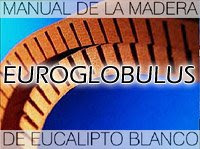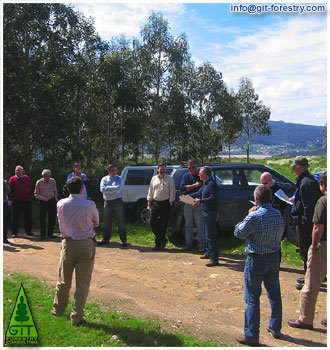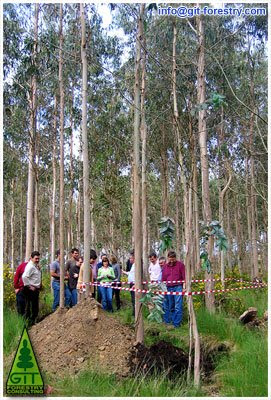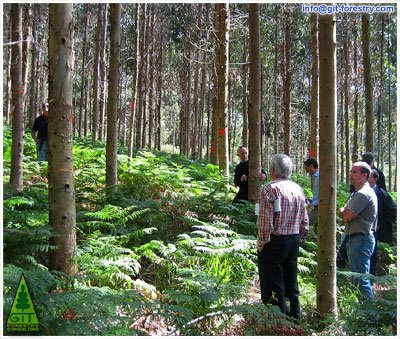Or seven reasons why stating eucalypts poison soils is mostly... bullshit

GIT Forestry Consulting - Consultoría y Servicios de Ingeniería Agroforestal - www.git-forestry.com - EUCALYPTOLOGICS
We frequently receive inquiries at EUCALYPTOLOGICS from concerned gardeners, horticulturalists and even Eucalyptus timber plantation owners in regard to the widespread notion of these trees "being poisonous to the soil" and "dangerous for understorey flora". Today we hope to help throw some light over this myth.
 Fig. 1: Healthy understorey plants growing under an Eucalyptus tree. Image courtesy Dan Anderson, www.tree-species.com (Click image to enlarge)
Fig. 1: Healthy understorey plants growing under an Eucalyptus tree. Image courtesy Dan Anderson, www.tree-species.com (Click image to enlarge) Fig. 2: Monumental Eucalyptus camaldulensis growing among palms in the Inca Botanical Garden of Malaga, Spain. Image courtesy Dan Anderson, www.tree-species.com (Click image to enlarge)
Fig. 2: Monumental Eucalyptus camaldulensis growing among palms in the Inca Botanical Garden of Malaga, Spain. Image courtesy Dan Anderson, www.tree-species.com (Click image to enlarge)The answer could not be more simple: because a plant causing alelopathic effects on its surrounding habitat is not equivalent to a plant keeping infinite arsenals for chemical warfare that affect everything around it.
SEVEN KEY QUESTIONS ON EUCALYPTUS POISIONING SOILS
Question 1: What is alelopathy?
Question 2: Are Eucalyptus alelopathic plants?
Question 3: Does alelopathy in Eucalyptus have something to do with they being exotic species?
Question 4: How do Eucalyptus alelopathic effects impact other plants?
The combined action of at least...
- Natural events to which many Eucalyptus species have adapted their reproductive processes (e.g. fire) while other plants have not, making less desirable habitat for non adapted to some plants while favouring others
- Fast development of root systems compared to some plants, which can give them quicker access to soil moisture and making less desirable habitat for water demanding plants there while favouring others
- Quick canopy development and litter formation, meaning quick shading of understorey and making less desirable habitat for full sun plants there while favouring others
- And the release of natural organic alelo-chemical compounds to the soil, which can inhibit germination of certain plant seeds while favouring others or contribute directly or indirectly to the slower growth of some plants while favouring others
For the case of alelo-chemical compounds considered as a single factor in this equation, each different plant taxon will behave differently, some totally tolerating the available amount of alelo-chemicals perfectly, some being affected to a certain degree, and some being non tolerant. It is a dynamic process, and it activates further adaptative processes in all the other plants. Those unaffected will keep growing and reproducing, those non critically affected will evolve towards tolerance given enough genetic variability so some will keep on growing and reproducing, and those non tolerant will be replaced in their ecologic niche by other organisms that will keep growing and reproducing. Evolution under our noses.
A dynamic ecosystem in continuous adaptation. But not anihilation, sterilisation or desertification. Again, pay attention when you any of these or similar terms together in the same sentence, statement or argument in a discussion, as it normally will give you hints on the speaker.
Question 5: Can we safely grow other plants under Eucalyptus in our gardens?
Each of your gardens will become a real laboratory and you will have the opportunity to observe what is going on and realize that you cannot blame alelopathy for your other plants dying if you have not watered them during that severe summer drought.
But, to not let you go with empty pockets, enough mentioning quickly that, the same way you can grow garden plants in the understorey of an eucalypt, many possibilities arise for a wider scale policulture (simultaneous cultivation on the same soil) involving Eucalyptus as tree cover. There are countless examples of these agroforestry systems in all five continents, from relatively simple ones involving pasture or natural grazelands plus Eucalyptus trees (silvopasture) to relatively complex serial crops (multicrop) as sugarcane plus Eucalyptus; maize plus Eucalyptus; pineapple plus Eucalyptus; coffee plus Eucalyptus; Leucaena plus Eucalyptus; cotton plus Eucalyptus; rice, beans and Eucalyptus... as many combinations as adventurous agronomists.
As you can imagine, if the myth of Eucalyptus sterilising soils or making it unusable for every other plant sustained itself, none of these would be possible. But they are. Yet once again, pay attention when you see any of these or similar terms together in the same sentence, statement or argument in a discussion, as it normally will give you hints on the speaker.
Question 7: Why is the myth of Eucalyptus poisoning soils so popular then?
Because the average urbanite Western citizen is deeply ignorant on agriculture, forestry, the dynamics of ecosystems or long term evolution of landscape parameters by human action.
Because the average gardener, farmer, landowner or investor in trees is too busy making a project work to find time for independent assessment of such questions.
And because there are individuals with either high levels of ignorance, narrow vision or enough knowledge but despicable moral behaviour who keep promoting myth over science and propagating fallacies to discredit one of the most versatile, efficient, productive and diverse plant groups in the world. Genus Eucalyptus.
To all these but especially the last kind, EUCALYPTOLOGICS cordially extends an invitation to join foresters, agronomists and farmers of the world for manual understorey control on those plants that do not grow under Eucalyptus, to grab a tool and labour the understorey crops of Eucalyptus based agroforestry systems that cannot grow on sterilised soils and to enjoy the wildlife that cannot live under the protection of these trees. You can bet that a huge percent of them won't abandon their comfortable chairs for the challenge and will keep behaving like ostriches.
Subscribe to receive EUCALYPTOLOGICS via RSS














































